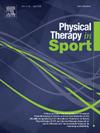评估髋关节伸展时腘绳肌功能及其与最大冲刺速度关系的测试的可靠性:一项横断面研究
IF 2.2
3区 医学
Q1 REHABILITATION
引用次数: 0
摘要
目的建立评估髋部伸展时腘绳肌功能的三种测试方法的重测信度,并探讨其与最大冲刺速度的关系。SettingBiomechanics实验室。参与者:20名身体健康,身体活跃的男性(年龄= 26±5岁;高度= 1.81±0.07 m;体重= 81±7公斤)。在测试和重新测试期间,参与者在非机动跑步机上进行了最大短跑速度测试(NMT)和三个评估腿筋功能的测试(腿筋踏板车,腿筋推和腿筋转换),间隔7天。使用NMT测量腿筋滑板车的峰值水平力,而使用力板测量腿筋推动和腿筋切换的峰值髋部伸展力(forcedeck Lite, Vald Performance, Brisbane, Australia)。我们分别计算了(ICC2,1)次测试和再测试以及(ICC2,k)次测试和再测试之间的95%置信区间(95% CI)的每个测试的类内相关系数(ICC),以及与最大短跑速度的Pearson相关系数(r值)。结果所有测试的重测信度均为中等至优异。腿筋滑板车是唯一具有统计学显著相关性的测试(p <;0.01;R = 0.76)与最大冲刺速度有关。结论本研究所描述的测试均具有中等至优异的测试再测试信度,但只有腿筋滑板车与最大短跑速度相关。本文章由计算机程序翻译,如有差异,请以英文原文为准。
Reliability of tests assessing hamstring function during hip extension and their associations with maximal sprinting speed: a cross-sectional study
Objective
Establish test re-test reliability of three tests assessing hamstring function during hip extention and investigate their associations with maximal sprinting speed.
Design
Cross-sectional.
Setting
Biomechanics laboratory.
Participants
Twenty healthy, physically active men (age = 26 ± 5 years; height = 1.81 ± 0.07 m; body mass = 81 ± 7 kg).
Main outcome measures
Participants performed a maximal sprinting speed test on a non-motorised-treadmill (NMT) and three tests assessing hamstring function (hamstring scooter, hamstring push and hamstring switch), during test and re-test sessions seven days apart. Hamstring scooter peak horizontal force was measured using the NMT, while hamstring push and hamstring switch peak hip extension forces were measured using force plates (ForceDecks Lite, Vald Performance, Brisbane, Australia). We calculated each test's intraclass correlation coefficient (ICC) with 95% confidence intervals (95% CI) within (ICC2,1) test and re-test sessions, respectively, and between (ICC2,k) test and re-test sessions, along with Pearson's correlation coefficient (r-value) with maximal sprinting speed.
Results
Test re-test reliability ranged from moderate to excellent for all tests. The hamstring scooter was the only test with a statistically significant association (p < 0.01; r = 0.76) with maximal sprinting speed.
Conclusions
The tests described in this study all had moderate to excellent test re-test reliability, but only the hamstring scooter was associated with maximal sprinting speed.
求助全文
通过发布文献求助,成功后即可免费获取论文全文。
去求助
来源期刊

Physical Therapy in Sport
医学-康复医学
CiteScore
4.50
自引率
8.30%
发文量
125
审稿时长
39 days
期刊介绍:
Physical Therapy in Sport is an international peer-reviewed journal that provides a forum for the publication of research and clinical practice material relevant to the healthcare professions involved in sports and exercise medicine, and rehabilitation. The journal publishes material that is indispensable for day-to-day practice and continuing professional development. Physical Therapy in Sport covers topics dealing with the diagnosis, treatment, and prevention of injuries, as well as more general areas of sports and exercise medicine and related sports science.
The journal publishes original research, case studies, reviews, masterclasses, papers on clinical approaches, and book reviews, as well as occasional reports from conferences. Papers are double-blind peer-reviewed by our international advisory board and other international experts, and submissions from a broad range of disciplines are actively encouraged.
 求助内容:
求助内容: 应助结果提醒方式:
应助结果提醒方式:


